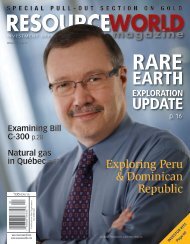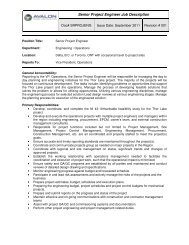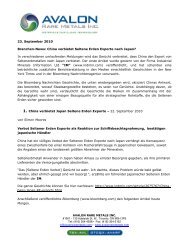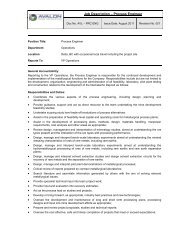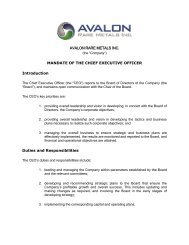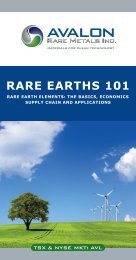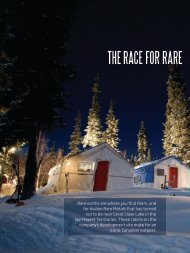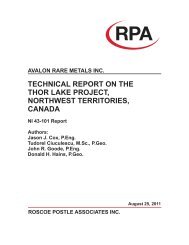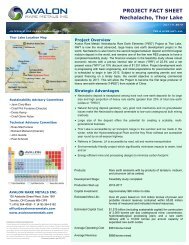technical report on the nechalacho deposit, thor lake project ...
technical report on the nechalacho deposit, thor lake project ...
technical report on the nechalacho deposit, thor lake project ...
Create successful ePaper yourself
Turn your PDF publications into a flip-book with our unique Google optimized e-Paper software.
Semi-quantitative X-ray diffracti<strong>on</strong> (XRD) analyses determined that <strong>the</strong> Nechalacho samples<br />
tested were predominantly comprised of silicates with minor to moderate amounts of<br />
oxides/hydroxides. Albite, microcline and quartz were identified as <strong>the</strong> dominant silicate<br />
minerals, while magnetite and hematite were identified as <strong>the</strong> dominant oxide minerals.<br />
Moderate to trace amounts of carb<strong>on</strong>ate minerals were also documented.<br />
Due to <strong>the</strong> sample matrix and high levels of rare earth elements (REE), semi-quantitative XRD<br />
analyses could not be completed <strong>on</strong> <strong>the</strong> c<strong>on</strong>centrates. Qualitative XRD results for <strong>the</strong><br />
c<strong>on</strong>centrate samples did, however, indicate that <strong>the</strong> c<strong>on</strong>centrates were also comprised<br />
predominately of silicates and oxides. The Qemscan results dem<strong>on</strong>strate that 56% of <strong>the</strong><br />
c<strong>on</strong>centrate sample comprises rare earth minerals and zirc<strong>on</strong>, 31% of <strong>the</strong> sample is silicates,<br />
almost 9% carb<strong>on</strong>ates and <strong>on</strong>ly 0.7% sulphides.<br />
Leach tests were performed <strong>on</strong> <strong>the</strong> ore, c<strong>on</strong>centrate, tailings and waste rock. Shake flask<br />
extracti<strong>on</strong> leachates showed that waste rock was alkaline, while acid base accounting tests<br />
showed that <strong>the</strong> ore and c<strong>on</strong>centrate were potentially acid neutralising, with generally low<br />
sulphur and higher carb<strong>on</strong>ate neutralising potential. Most tests <str<strong>on</strong>g>report</str<strong>on</strong>g>ed pH values and o<strong>the</strong>r<br />
parameters within World Bank limits with <strong>the</strong> excepti<strong>on</strong> of total suspended solids in <strong>the</strong> fresh<br />
tailings soluti<strong>on</strong>.<br />
Settling tests <strong>on</strong> <strong>the</strong> tailings samples c<strong>on</strong>cluded that <strong>the</strong> suspended solids would settle out of<br />
<strong>the</strong> slurry fairly quickly. In <strong>the</strong> lab, solids settled out of <strong>the</strong> slurry in two to two and a half hours,<br />
reaching terminal density shortly <strong>the</strong>reafter. Tests also c<strong>on</strong>cluded that drainage would improve<br />
<strong>the</strong> rate of settling of solids.<br />
The radi<strong>on</strong>uclide analysis of <strong>the</strong> Nechalacho solids typically <str<strong>on</strong>g>report</str<strong>on</strong>g>ed increased levels of<br />
radi<strong>on</strong>uclides in <strong>the</strong> c<strong>on</strong>centrate samples in comparis<strong>on</strong> to <strong>the</strong> ore composites, while tailings<br />
<str<strong>on</strong>g>report</str<strong>on</strong>g>ed lower levels than <strong>the</strong> ore samples.<br />
Regulati<strong>on</strong>s governing radioactivity include:<br />
• Transportati<strong>on</strong> of Dangerous Goods Regulati<strong>on</strong>s (TDGR), with limit of 70 Bq/g;<br />
• Health Canada Regulati<strong>on</strong>s <strong>on</strong> Naturally Occurring Radioactive Material (NORM);<br />
• Northwest Territories Mine Health and Safety Act and Regulati<strong>on</strong>s which require c<strong>on</strong>trol<br />
<strong>on</strong> worker exposures where rad<strong>on</strong> decay product levels exceed 0.4 WLM/y (Working<br />
Level M<strong>on</strong>ths per year); and<br />
• Canadian Nuclear Safety Commissi<strong>on</strong> if uranium and/or <strong>thor</strong>ium materials are produced.<br />
Thor Lake has uranium levels that are higher than average naturally occurring granite but are<br />
below levels typically experienced in o<strong>the</strong>r rare earth <strong>deposit</strong>s. The <strong>thor</strong>ium levels in <strong>the</strong><br />
Nechalacho <strong>deposit</strong> are anomalous, but given <strong>the</strong> lower radioactivity equivalency of <strong>thor</strong>ium<br />
Technical Report 43-101 – March 13, 2011 Page 18-99<br />
Prepared by Aval<strong>on</strong> Rare Metals Inc.





